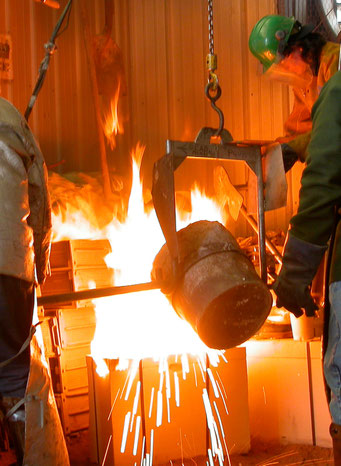Process
How I cast my work:

I was trained in the "Lost Wax" method of casting but gradually became more interested in the "Direct Replacement" style of working because it involves an element of chance and the results are therefore less predictable. I like not knowing how my casting will turn out until I break open the mould and see the finished piece. Direct Replacement involves making a sculpture out of a combustible material, packing it into a heat-resistant mould, and pouring molten metal into the mould which volitizes the flammable material and instantly creates a metal version of the original piece. Here is the process in photos:

This is a pair of cowboy boots I made out of polyethylene foam. I make the clothes, boots, etc. by hand out of this material, then add nuts and bolts for decoration. The nuts and bolts go through the process and will be cast in place.

The next step is to make a sand mould around the foam pieces. A box is used to hold the loose sand in place around the piece until the resin binder in the sand hardens.

The sand must be packed or "rammed" very tightly around the foam pieces. This is a critical aspect of the process as the gesture the form takes is determined during this step. This is where chance comes into play because I cannot completely control how the sand shapes the foam.

There are several steps required before the sand moulds are ready to receive metal, but they're technical and rather boring so I won't describe it in detail.

When the moulds are ready they are lined up so the caster can easily get to them during the pour. Each of the moulds in this photo weighs more than 300 lbs.

The metal is heated to the desired pouring temperature. In this case, we're melting iron and will pour it at 2600 degrees Fahrenheit.

Pouring iron. I'm standing on my sand moulds because it was the best way to manuever the 300 lb ladle of iron over the pouring cup--you don't want to miss the cup when pouring hot metal. The aluminized pants protect my legs from the intense heat.

Breakout. After the castings have completely cooled they can be broken out of the moulds using a variety of tools. This is the most exciting part of the process because I see the sculpture in metal for the first time.

Here are the fnished rough-casts after they have been broken out of their moulds. After this, the long job of cleaning and finishing the piece begins.

